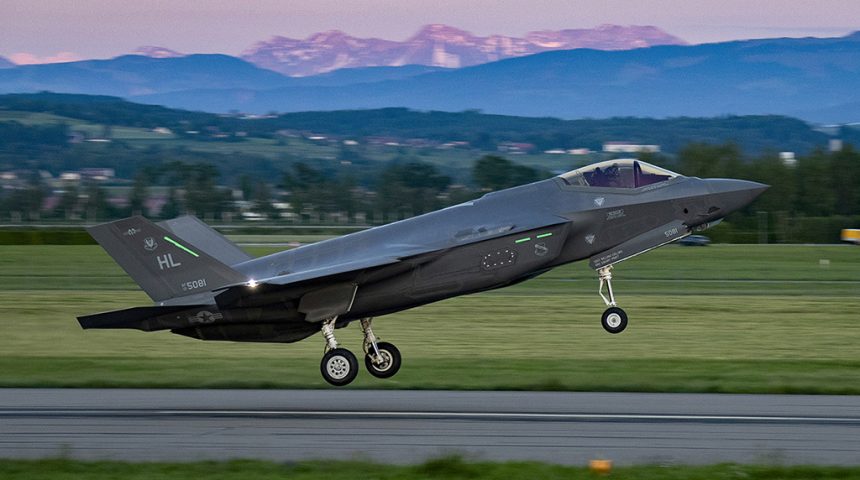According to a Swiss public television report the Lockheed Martin F-35 is well ahead of its competitors in the race for the next Swiss Air Force fighter.
On Monday Jun. 21, 2021, the Swiss public television SRF reported that the Lockheed Martin F-35 has won the Swiss evaluation to find a replacement for F-5 Tiger and F/A-18C/D Hornet jets currently in service with the Swiss Air Force.
Three independent sources confirmed the “Rundschau” (a political and economic program on Swiss Radio and Television – SRF) that: “Both financially and technically, the stealth jet is well ahead of the F / A-18 Super Hornet, the Eurofighter and the Rafale. Defense Minister Viola Amherd (Die Mitte) therefore has no choice but to apply to the Federal Council to buy the F-35. The DDPS [Federal Department of Defence, Civil Protection and Sport] itself refuses to comment and refers to the confidentiality of Federal Council business. According to insiders, the preparations for the eagerly awaited Federal Council decision are well advanced. A media release had already been written about the purchase of the F-35 in draft – but the entire Federal Council could still decide otherwise.”
In 2014, when a referendum rejected the acquisition of the Saab Gripen (to replace the F-5E), the Swiss Air Force launched “Air 2030” program aimed to the selection of its future fighter. As part of the program, the service carried out the evaluation of four candidate aircraft: the Eurofighter Typhoon, the Boeing F/A-18 Super Hornet, the Dassault Rafale, and the Lockheed Martin F-35. A fifth candidate, Gripen E, was retired before its evaluation even started after the Swiss procurement agency, “formally recommended” that Saab stayed home as flight tests had been designed to only evaluate aircraft that were operationally ready in 2019.
On Jan. 10, 2020, armasuisse issued the second RFQ for new fighter aircraft to the government authorities where the four potential suppliers are located: Germany (Airbus Eurofighter), France (Dassault Rafale) and the U.S. (Boeing F/A-18 Super Hornet and Lockheed Martin F-35A).
“The second request for proposal is based on the analysis of the first proposal and on findings from flight, simulator and ground tests as well as audits with armed forces operating the evaluated fighter aircraft. In the second request for proposal, the companies contacted via the government authorities are requested to submit the most advantageous offer for Switzerland.
The proposal should include the following elements:
- prices for 36 and 40 aircraft, including defined logistics and weapons, as a binding starting point for the detailed negotiations with the selected candidate after the type selection
- offers for cooperation between the armed forces and the procurement authorities of Switzerland and those of the supplier country
- envisaged or already initiated offset projects”
In September 2020, Swiss voters narrowly approved a CHF6 billion (6.49B USD) funding packet that allowed the Swiss Air Force to go ahead with the purchase of new aircraft.
Therefore, in spite of the criticism and well known issues, it looks like the F-35 has convinced the Swiss Air Force that it has an edge on its three competitors, not only from a technical point of view but also in terms of cost. According to the insiders who talked to SRF, Switzerland can buy a larger number of F-35s with the budgeted 6.5 billion USD than would be the case with the three competitors.
Its simulator is also mentioned as one of the keys of its (alleged) success in Switzerland: it allows the Swiss Air Force to carry out significantly more training missions than with the competition. This is particularly interesting, especially if we consider what other partner nations are doing (or not doing) in terms of LVC (Live Virtual Constructive)
Indeed, in the field of virtual reality and simulators, the future is represented by the LVC architectures that allow the interconnection of airplanes in flight with land-based simulators via datalinks so as to create very complex scenarios involving CGF (Computer Generated Forces). “The F-35 is ready for LVC. However, at the moment, there are cybersecurity criteria and operational relevance considerations that make its use premature: it is a segment that has not reached the level of maturity necessary to be employed operationally,” told us Col. Marzinotto, the commander of the 32° Stormo (Wing), the Italian Air Force unit that has been the first to operate the F-35 in Europe. “In the future, the need to connect in-flight aircraft and simulators will be reconsidered, but for the time being such hybrid scenarios are not part of the training process of the Italian F-35 pilots.” It would be interesting to understand whether the simulator system showcased to the Swiss Air Force is the same used by the Italian Air Force or is an upgraded version that has possibly reached the level of maturity the Italians hoped for.
Anyway, the winner of the Swiss competition should be formally announced by June 30, 2021 and the delivery of the new aircraft is slated to start in 2025 and end in 2030, if everything goes as planned…
In fact, while the decision will be taken by the entire Federal Council at least two of the seven Federal Council members would prefer a European fighter jet, SRF said, and critics (including the Group for a Switzerland without an Army, the leftwing Social Democratic Party and the Green Party) have promised to launch a referendum against any decision to buy a U.S. fighter jet. They fear that data sovereignty and security would not be guaranteed and would prefer the Swiss pilots to fly Eurofighter or Rafale. Let’s see what happens: the decision, as it often happens, will not be “just” technical.









